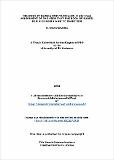Files in this item
The Book of Daniel and manticism: a critical assessment of the view that the Book of Daniel derives from a mantic tradition
Item metadata
| dc.contributor.advisor | Davila, James R. | |
| dc.contributor.author | Wooden, R. Glenn | |
| dc.coverage.spatial | 415 | en_US |
| dc.date.accessioned | 2012-06-11T13:54:10Z | |
| dc.date.available | 2012-06-11T13:54:10Z | |
| dc.date.issued | 2001 | |
| dc.identifier | uk.bl.ethos.491733 | |
| dc.identifier.uri | https://hdl.handle.net/10023/2727 | |
| dc.description.abstract | This dissertation examines the consensus view that is based on Hans-Peter Müller's 1969 and 1972 articles: Daniel was a mantic wise man in the Mesopotamian ASA court, and this was the self-understanding or aspiration of the maskilim of Dan 11:33, 35, 12:3, 10, who wrote the book. Chapter 1 reviews the arguments that make the mantic connection and Chapter 2 concludes that a direct connection with the Danes of Aqht, Ezek, and Jub, and with the angel in 1 Enoch should be rejected. There is evidence that the tradition of a priest in Ezra 8: 2 and Neh 10: 7, and found also in the superscription to the Old Greek of Bel, and 4 Ezra 12:10-11, and suggested the name. Chapter 3 concludes that the portrayal of the court diviners in Dan 1-6 is wholly negative and includes both the diviners, and the essence of the professions, i. e., the ability to interpret a divine revelation. The critique is conveyed through the story line, explicit criticisms, irony, and humour. Chapter 4 concludes that Daniel, the interpreter of dreams and the writing on the wall, is distinguished from every other character and role. In the final form of Dan, Daniel as the divinely assisted each time he interprets, just as when he receives help from an interpreting angel in Dan 7-12. Chapter 5 demonstrates that the portrayal of Daniel as the divinely assisted interpreter makes sense of the reinterpretation of old prophecies against the Assyrians as prophecies against Antiochus IV Epiphanes. Hab 2:2-4 and Isa 52-53 were also understood as predictions about the maskilim themselves. Comparisons are then made with the Teacher of Righteousness, the writers of the Hodayot, and with three Essenes portrayed by Josephus. These too were portrayed as divinely assisted interpreters. | en_US |
| dc.language.iso | en | en_US |
| dc.publisher | University of St Andrews | |
| dc.rights | Creative Commons Attribution-NonCommercial-NoDerivs 3.0 Unported | |
| dc.rights.uri | http://creativecommons.org/licenses/by-nc-nd/3.0/ | |
| dc.subject.lcc | BS1555.W7 | |
| dc.subject.lcsh | Bible. O.T. Daniel.--Criticism, interpretation, etc. | en_US |
| dc.title | The Book of Daniel and manticism: a critical assessment of the view that the Book of Daniel derives from a mantic tradition | en_US |
| dc.type | Thesis | en_US |
| dc.type.qualificationlevel | Doctoral | en_US |
| dc.type.qualificationname | PhD Doctor of Philosophy | en_US |
| dc.publisher.institution | The University of St Andrews | en_US |
This item appears in the following Collection(s)
Except where otherwise noted within the work, this item's licence for re-use is described as Creative Commons Attribution-NonCommercial-NoDerivs 3.0 Unported
Items in the St Andrews Research Repository are protected by copyright, with all rights reserved, unless otherwise indicated.


